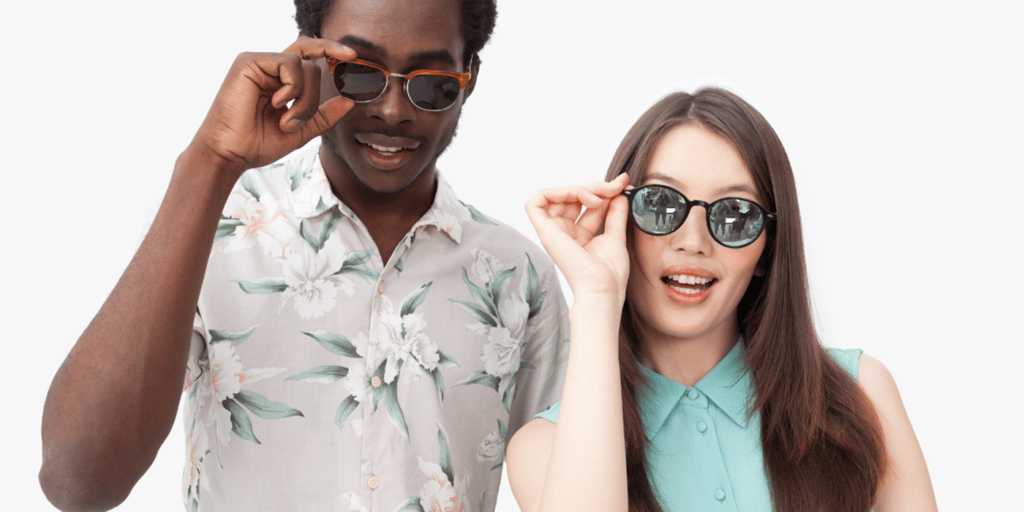
Eye Care | Protect Your Eyes From The Sun
Summer is in full swing, and you know what that means—FUN IN THE SUN! Our bodies benefit from spending time in the sun—natural light elevates Vitamin D levels, boosts our moods, and aids nighttime sleep. Overexposure to the sun, however, can be harmful to our health. Chances are you’re already taking steps to moderate your sun exposure, wearing sunscreen and drinking lots of water to stay hydrated. But have you thought about how sun exposure affects your vision? Today we’re taking a deep dive into the importance of protecting our eyes this summer as well!

SUN EXPOSURE AND YOUR EYE HEALTH
The sun emits Ultraviolet (UV) radiation. The strength of UV rays varies depending on many factors: distance from the equator, altitude, season, reflection off surfaces, air quality, and cloudiness (it’s important to know that UV rays can travel through clouds). Two types of UV rays cause eye problems: UV-A rays injure the macula at the back of your eye, and UV-B rays hit the cornea and lens at the front of the eye.
SUN-RELATED EYE DISEASES
Over time, exposure to the sun’s UV rays can damage your eyes and increase your risk for short-term eye problems and long-term eye diseases:
Caused by short-term exposure to UV rays, Photokeratitis is essentially a sunburn on the eye. This condition occurs most often because of sun exposure in snowy environments and at the beach. Symptoms of Photokeratitis include redness and pain.
Cataracts are a condition caused by years spent in the sun. Long-term exposure to UV rays causes the eyes’ lenses to become cloudy. Symptoms of cataracts include blurriness, light sensitivity, and difficulty seeing at night. Cataracts can be removed only through surgery.
Macular degeneration, caused by genetics and long-term sun exposure, involves the breakdown of the macula and resulting loss of central vision. Symptoms of macular degeneration include seeing straight lines as wavy or bent and difficulty adjusting vision to dark places.
Growths on the eye, also known as “surfer’s eye” or Pterygium, can result from UV rays, wind, and dust hitting the eye. Pterygium can begin as pinguecula, or yellow growths in or near the eye on the side of the nose, and range in size. Symptoms of growths on the eye include a bump or spot on the white of the eye; redness on the white of the eye; burning, itching, or dry eyes; and blurriness.
Cancer near the eye can result from exposure to UV rays over time. Made of thin skin, your eyelids are very susceptible to sun damage. The eye area is particularly vulnerable to nonmelanoma skin cancers. The most common type of cancer near the eyes is basal cell carcinoma. Symptoms of basal cell carcinoma include a waxy-looking bump; a brown, scar-like flat growth near the eye; or a sore that heals and then reappears. Squamous cell carcinoma and melanoma can also develop near the eye, though

TIPS FOR PROTECTING YOUR EYES THIS SUMMER
- Wear sunglasses. When shopping for shades, read the label closely and be particular! Your sunglasses should block 99 to 100% of UV-A and UV-B radiation. The Skin Care Foundation’s Seal of Recommendation is a good indication of this standard. Your sunglasses should also reduce glare and be comfortable to wear.
- Wear wide-brimmed hats and sunscreen. Hats with a 3-inch brim can cut sun exposure to the eyes and eyelids in half! Choose a sunscreen that you can use on your eyelids and closely surrounding the eye. Be sure to reapply throughout the day.
Be aware of high intensity sun conditions. The sun’s rays are strongest between 10 a.m. and 4 p.m. Intensity also increases in high altitudes, and near sand, water, and snow (all surfaces that reflect sunlight). If you’re at the beach (or skiing), wear sunglasses with a darker tint, as these block out more light.
WHO IS AT RISK FOR SUN DAMAGE TO THE EYES?
Everyone, including children, is at risk for eye damage. People who spend long hours working or playing outside are most at risk for sun-related eye problems, as are those who have certain retina disorders, who have had cataract surgery, and who are taking certain medicines. Because children’s eyes are not as effective at filtering the sun, eye protection is particularly important for them.
FINDING THE RIGHT PAIR OF SUNGLASSES AT THE MONOCLE IN-HOUSE OPTICAL BOUTIQUE
At Monocle, we offer individualized assistance with prescription and non-prescription sunglasses in our in-house optical boutique. With a passion for current fashion trends and eyewear, Dr. Llemit leverages her expertise and broad worldview to help patients select eyewear that complements their unique personality and style.
When you come to Monocle to select frames, you’ll experience the benefits of our digital technology that incorporates frame style, fitting, and wearing parameters to optimize your vision. We invite you to stop in and browse our collection of designer brands and independent lines offering highly engineered and eco-friendly frames at affordable prices.
For more information, contact us at 832.735.7332 or info@monoclewestu.com.
References:
https://www.skincancer.org/skin-cancer-prevention/sun-protection/eye-protection/
https://abbaeyecare.com/10-ways-to-protect-your-eyes-this-summer/
